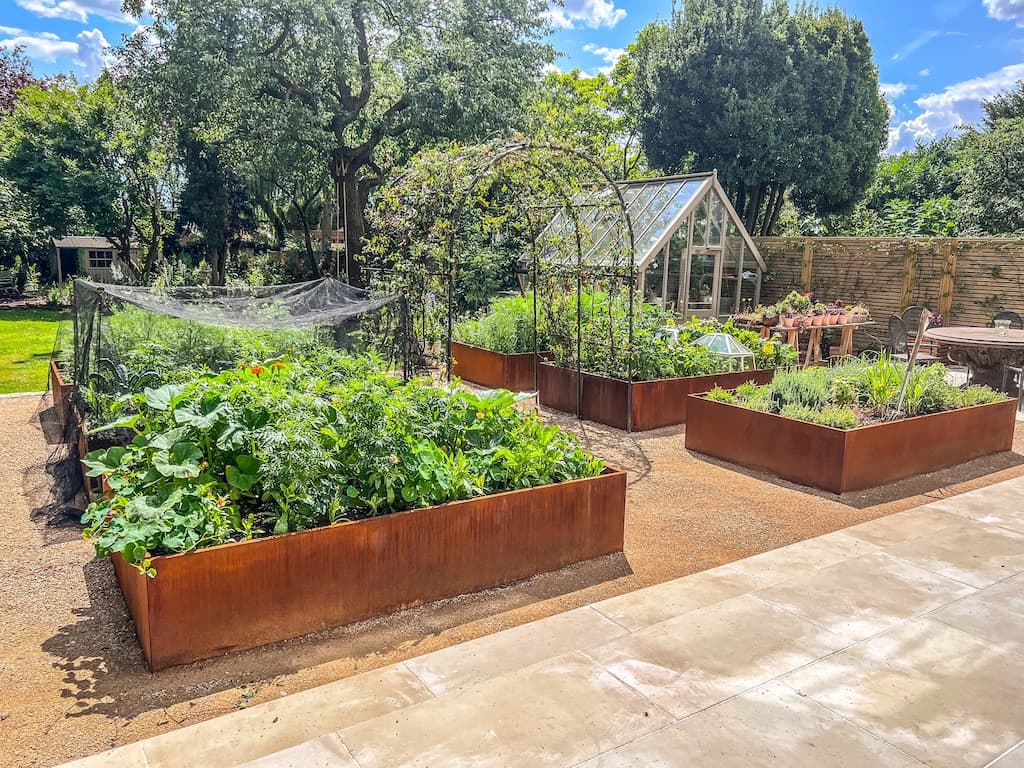Metal vs Wood Raised Garden Beds
Metal vs Wooden Raised Beds
Raised beds are increasingly popular as more and more people seek to grow their own fresh organic fruit and veg. Wood has traditionally been the go-to choice to make them from, but have you considered the advantages of metal raised beds instead?
In this article, we’ll compare the two types of materials in a range of areas and hopefully help you to decide which is best for your garden, allotment plot, or growing space.

Contents
Durability
One of the key advantages of metal raised beds is that they tend to last longer than wooden ones. Any of galvanised steel, powder-coated steel, or corten steel will typically have lifespans measured in terms of decades rather than the mere years you might get from wood. It is true that some types of wood like cedar and redwood have better lifespans than others but these tend to be more expensive. It is also the case that metal beds tend to endure harsh weather conditions, better than wood.
Maintenance
Raised metal garden beds will typically need little maintenance. They may benefit from a wash over to clean the surface should they get splashed with mud but this is for aesthetic reasons. It is also important not to damage the protective powder coating as this could allow rust to get in, but provided you avoid scratching the surface with hard, sharp objects this shouldn’t be a problem. An added bonus of corten steel is that any scratches will usually repair themselves because the protective coating re-forms.
Wooden raised beds, meanwhile, will often benefit from a renewing of their protective coating every so often in a similar manner to fence panels. Obviously, it is more difficult to re-treat or paint the inside of the beds so they are sometimes lined with plastic.
There is also the increased labour associated with wooden raised beds due to the plain fact that they will almost certainly need replacing more often than many of their metal counterparts.
Environmental impact
Wood may appear to be a more sustainable material at first glance, particularly if it is sourced from sustainable FSC UK sources. However, when you consider that wooden raised beds will need replacing that much more frequently than metal they begin to look less favourable. When you add to this that metal raised beds can either be made from recycled metal or be recycled, they begin to look more attractive despite the large amount of energy needed to manufacture them.
Another factor is that wood will probably need treating with some type of preservative in order to prolong its life. Now, many of these preservatives are much less toxic than used to be the case, but they are still likely to be at least as problematic as any coating that is used on steel. The likes of galvanised steel or corten steel may well leach some trace metals into the soil but as these will be things like zinc and iron, which are important micro-nutrients for plants anyway, this poses little to no problem and may even be beneficial.
Aesthetics and design flexibility
As we all know, beauty is in the eye of the beholder. You may simply prefer the traditional look of wood to metal, but with the range of different types of metal available, have you considered them all? Corten raised beds, for example, will lend a very industrial look to a space once it is weathered, and also a unique one as no two raised beds will ever quite weather exactly the same.
Powder-coated garden beds, meanwhile, come in quite an array of colours and will provide a slightly more modern look, while galvanised steel can still give quite an old-fashioned look reminiscent of old-school lead planters but also looks sleek and professional.
With all of the different looks that the different types of metals offer, metal raised beds arguably offer a wider range of possibilities when it comes to the effect you want to achieve in your outdoor space. They also come in a large number of sizes and shapes. You can get circular bottomless metal planters and have the option of introducing curves into your metal raised bed design – something that is much more difficult with wood.
Cost
There are no two ways about it: most wooden beds will be cheaper than most steel beds as a one-off purchase. However, when you take into account their respective lifespans and any other advantages, metal can quickly become better value over a period of 30 years or more.
Mild steel raised beds are among the cheapest metal raised beds on the market but won’t last anywhere near as long as the likes of corten or galvanised steel raised beds. Redwood and cedar are quite long-lasting wooden types, but they are among the more expensive in that material.
Growing conditions
Quite a lot is written about whether metal raised beds overheat plants or wooden ones suck moisture out of the soil. These factors tend to be negligible in impact or make no difference at all. The soil right next to the metal of raised beds may get warmer than is the case with wood but this shouldn’t pose a problem to your plants in larger raised beds.
For smaller containers, if you are worried about overheating or freezing then you can add some insulation board around the inside walls when planting up your raised bed. Wood may also insulate the soil better and keep a more constant temperature, while metal is likely to warm up slightly quicker on a sunny morning and cool down more quickly at night.
Wooden raised beds may provide more attractive hiding places for slugs and also prove to be more attractive to termites, if they are an issue in your climate, or even rodents. The wood may also dry out the compost in your beds a little more than metal in certain circumstances, but really, added together, the difference in growing conditions in a metal raised bed compared to a wooden one is likely to be minimal. The much more important factor is the quality of the soil or compost you use and how you maintain it.
The Final Verdict
The main factors to consider when making a choice between the two materials are the increased durability of metal raised beds compared to the lower upfront cost associated with wooden raised beds. Of course, other factors like aesthetics and environmental impact also come into play.
Ultimately, it is a personal decision that depends on your circumstances and there is no right or wrong answer, but hopefully this article has given you some food for thought as you plan your food or ornamentals growing space!
